Making The Low GWP Transition Simple & Safe
Across North America and beyond, the HVAC industry is converting to refrigerants with lower global warming potential.
It’s a new era in HVAC, and Lennox is here to support your seamless transition. From newly enhanced energy-efficent and climate-friendly product lines to expanded resources, expert training and comprehensive support—we’re with you every step of the way.
BACKGROUNDWhat's Changing And Why?
Beginning January 1, 2025, new HVAC equipment must use refrigerants with a global warming potential, or GWP, under 700. GWP measures how much heat a gas traps in the Earth’s atmosphere relative to carbon dioxide (CO2). A gas with a lower GWP traps less heat, which is better for the Earth.
This means refrigerants with higher GWP, such as R-410A, will be phased out and replaced by more environmentally friendly refrigerants with a lower GWP, like R-454B and R-32. This shift to Low GWP refrigerants will reduce CO2 emissions by 4.6 billion metric tons between 2022 and 2050.
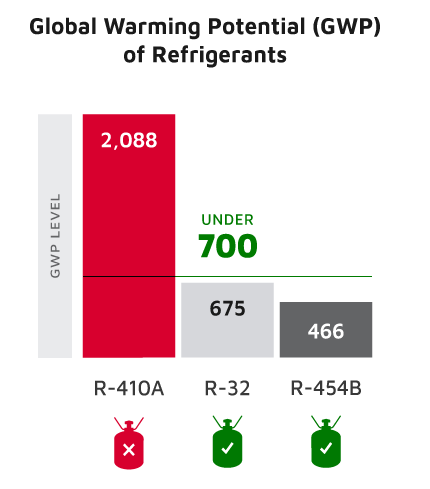
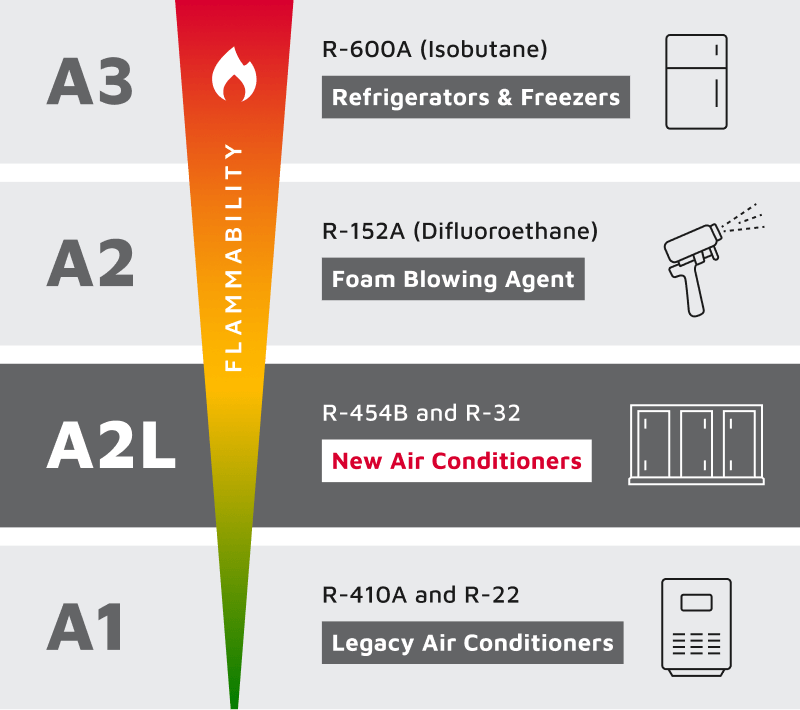
The new Low GWP refrigerants, like R-454B and R-32, fall into the A2L classification and offer a balance between safety and environmental impact. A2L refrigerants are mildly flammable and have a low risk of ignition and spread, so they require some changes to handling and installation practices. These additional steps are important for safety and code compliance.
Sell-Through Dates
To help ease the transition, equipment produced before January 1, 2025, can still be installed for a limited time.
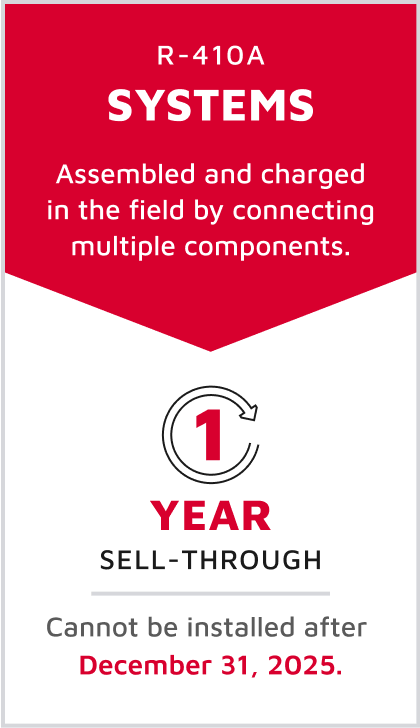
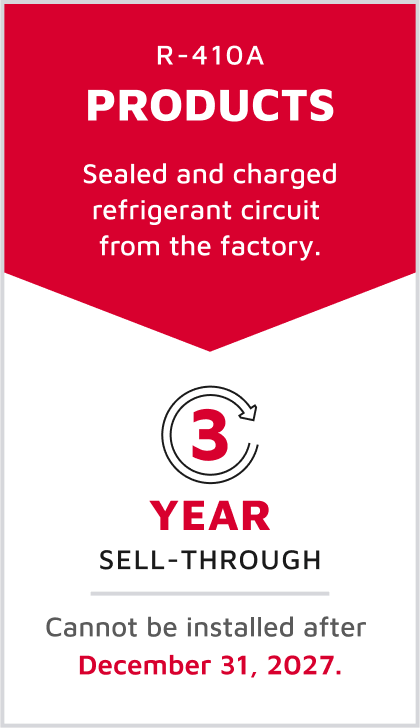
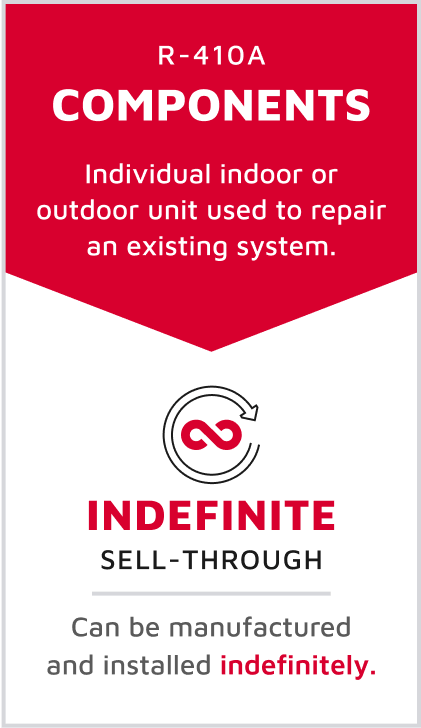
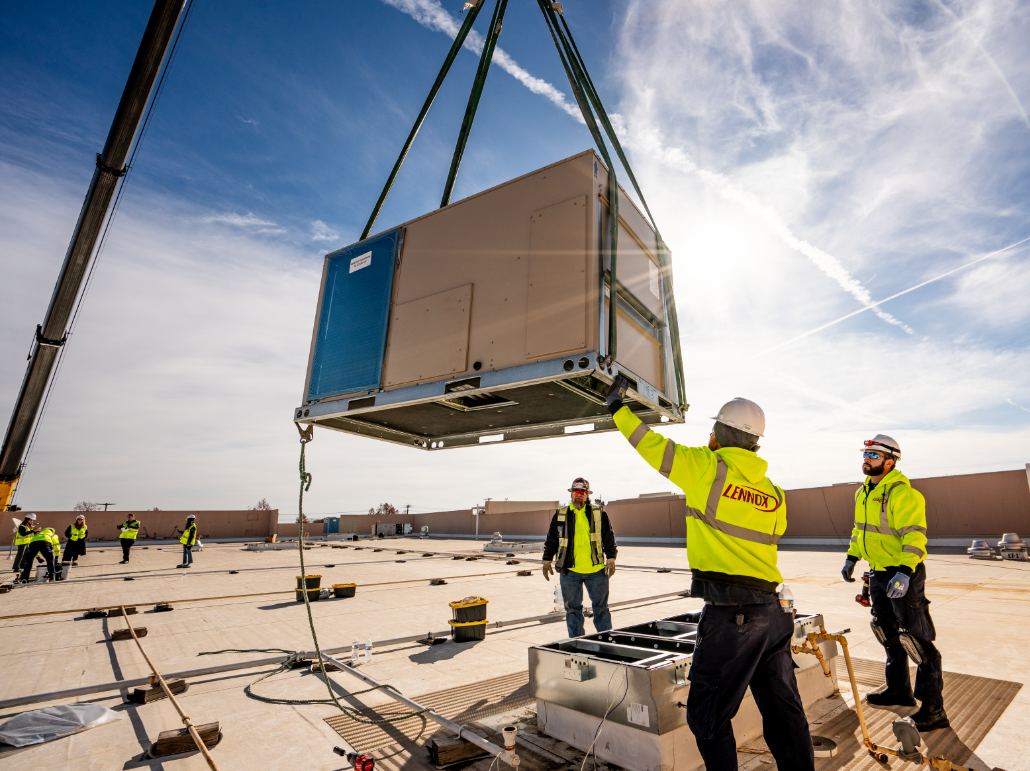
IMPACTHow It Affects You
These changes are happening across the industry and affect us all, and Lennox is working diligently to minimize the impact to our customers wherever possible.
Specifying Engineers
The new HVAC systems have been redesigned and optimized for performance with Low GWP refrigerants, and along with specification changes come new safety requirements and protocols. Beyond that, make sure to assess the impact Low GWP refrigerants will have on the building’s sustainability goals.
Mechanical Contractors
New equipment means new installation and handling practices, which may impact project budget and timelines. Take time to walk your clients through the safety enhancements and leak mitigation system. And when it comes to servicing or repairing legacy systems, components will be available indefinitely, but refrigerant will be increasingly limited over time.
Building Owners and Facility Managers
When the time comes to upgrade your HVAC system with one that’s optimized for Low GWP refrigerant, keep in mind that new safety requirements and installation protocols may impact the budget and timeline for replacement. Until then, components to service and repair your legacy system will continue to be available, but refrigerant will be increasingly limited over time.
If you’re about to break ground on a new building, check with your builder and mechanical engineer to ensure code-compliant HVAC systems will be specified and installed.
RESOURCES2025 Refrigerant Transition Guide
Find out what you need to know about the switch to Low GWP refrigerants with our comprehensive transition guide. From identifying A2L equipment and refrigerants to understanding the requirements and best practices for installation and handling. Plus, see how legacy equipment translates to the new Low GWP-compliant versions you need for 2025 and beyond.
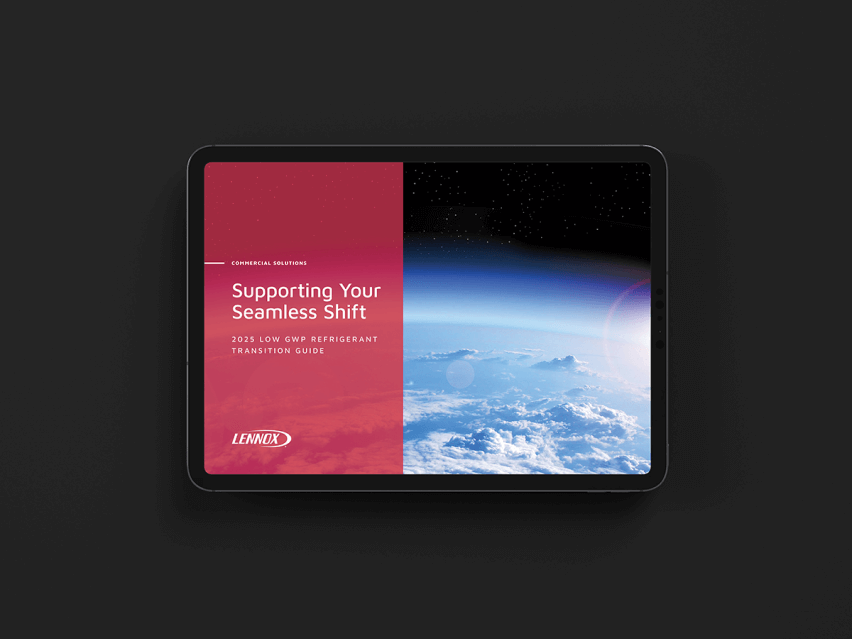
Preparing You for the Future of HVAC
Lennox is with you every step of the way. As you prepare to meet new regulations for commercial HVAC projects in 2025 and beyond , we’re providing you with training and tools you need to stay on top.
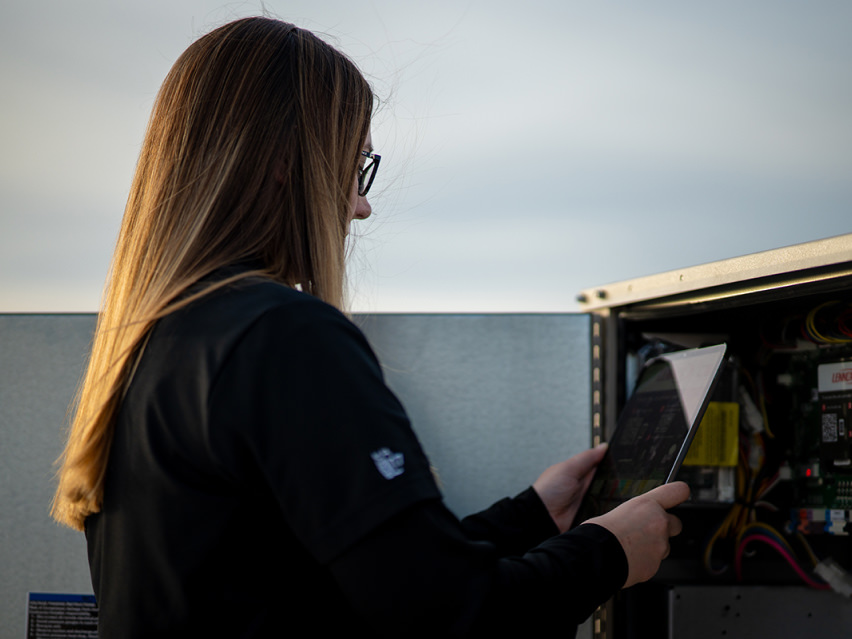
Product Literature
Hit the ground running with brochures and product information available at your fingertips.
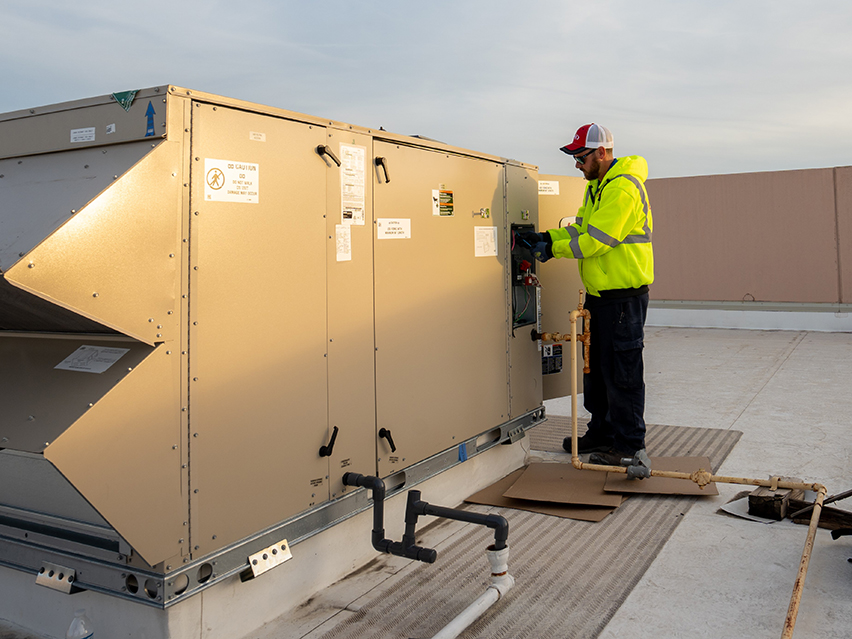
Technical Training
Find quick reference guides and technical training that you can easily access on the job.
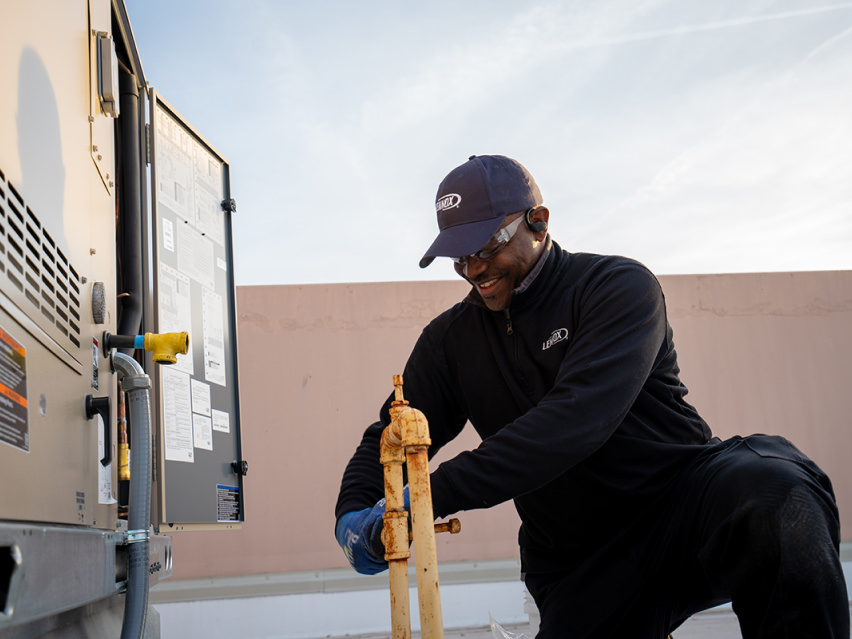
Customer Support
Get support when you need it most with a responsive team and expert advice.
FAQsFrequently Asked Questions
Get immediate answers to your top questions
GWP stands for Global Warming Potential, a metric developed by the Intergovernmental Panel on Climate Change (IPCC) to measure the amount of heat trapped in the atmosphere from greenhouse gases. While there is no strict legal definition for the term “Low GWP” refrigerant, it generally refers to refrigerants with a GWP of 700 or less, per the United States Environmental Protection Agency (EPA) Technology Transition Rule. R-454B has 78% lower global warming potential than R-410A.
The GWP, or Global Warming Potential, assesses a chemical’s environmental impact relative to carbon dioxide.
Carbon dioxide, or CO2, has a GWP of 1. In comparison, R-410A refrigerant has a GWP of 2,088, indicating that a pound of R-410A has a global warming impact 2,088 times greater than a pound of carbon dioxide.
A2L refers to an ASHRAE standard denoting low toxicity and low flammability. Both R-454B and R-32 are classified as A2L refrigerants. These ASHRAE standards play a crucial role in the development of codes and in shaping guidelines for safe handling.
A2L describes the ASHRAE safety classification of the new generation of refrigerants. Low GWP describes the lower global warming potential of those refrigerants. R-454B and R-32 are both accurately described as A2L and Low GWP.
Hydrofluorocarbons, or HFCs, are a class of manufactured greenhouse gases primarily used in air conditioning, refrigeration, foam blowing, and aerosols as replacements for the older classes of ozone-depleting substances, such as chlorofluorocarbons (CFCs) and hydrochlorofluorocarbons (HCFCs). While HFCs do not deplete the ozone layer, they are potent greenhouse gases with a high global warming potential, which has prompted governments to regulate and restrict their usage.
In December 2020, the U.S. President signed the American Innovation and Manufacturing (AIM) Act, a wide-ranging set of climate laws that empowered the Environmental Protection Agency (EPA) to reduce the harmful impacts of many chemicals. Acting on that legislation, the EPA has introduced various regulations focused on reducing the potential harm of refrigerants used in HVAC and other industries.
The U.S. Environmental Protection Agency (EPA) is taking a phased approach to cut down on the use of hydrofluorocarbons (HFCs) with higher global warming potential (GWP). As part of this transition, the EPA set an end date for the production of HVAC equipment that utilizes refrigerants with a higher GWP over 700, like R-410A. Beginning January 1, 2025, most newly manufactured HVAC equipment must utilize more environmentally friendly refrigerants with a GWP under 700, such as R-32 and R-454B.
After a lengthy phase-down period, the production and import of virgin R-22 was banned by the United States. The industry banned the production and import of R-22, which is categorized as a hydrochlorofluorocarbon (HCFC). Chlorinated chemicals, such as HCFCs, have been phased out because of their severe impact on the Earth’s ozone layer.
The industry then shifted to hydrofluorocarbons (HFCs), like R-410A. HFCs do not harm the ozone layer. However, they are potent greenhouse gases and have high global warming potential (GWP). Because of this, governments focused on reducing climate change are implementing regulations to phase out HFCs to protect the environment.
No. The EPA considered banning HFCs by their specific names but opted to permit the use of HFCs if incorporated into a blend with a global warming potential (GWP) below 700. R-32 is an HFC refrigerant, and is a component of R-454B.
A3 refrigerants, like isobutane and propane, are classified as highly flammable by ASHRAE. Technology, cost, and consumer acceptance of A3s are currently critical roadblocks. The current expectation is that another transition, potentially to A3s, may come in the mid-2030s.
The process to install an R-454B packaged unit will not differ meaningfully from R-410A models. Split systems will have changes in the way that refrigerant piping is installed throughout a building. Your local code authority should be consulted for specific requirements for refrigerant piping.
At the time of publication, there are no requirements for special certifications or re-certifications to install Low GWP equipment.
Yes. Since the units operate independently, equipment with different refrigerants can be mixed on the same building. Different refrigerants should never be mixed in the same unit.
Lennox has updated installation guides for all new equipment. For detailed instructions, visit the resource tab or specific product page on lennoxcommercial.com to view or download the installation guide.
New Low GWP systems are designed to provide similar levels of comfort, efficiency, and safety as current R-410A systems.
The new Low GWP equipment from Lennox is designed and rigorously tested to meet the strictest certifications, including commonly recognized UL (Underwriters Laboratories) certification, as well as ETL (Electrical Testing Laboratories) and CSA (Canadian Standards Association), among other independent certifications.
Effective January 1, 2025, the manufacturing of HVAC products and systems designed for use with higher-GWP refrigerants will be discontinued. Components intended only for repair of existing systems may continue to be produced for the time being, though that exception may be phased out in the future. See the Sell-Through Timing tab for additional information.
The new Low GWP units will have distinct nomenclature and adhesive labels. For Lennox packaged units, the number 5 identifies the change in refrigerant. For Lennox split systems, the letter K identifies the change in refrigerant. In addition, all Low GWP units will include a warning label (required by law) indicating the use of A2L refrigerants.
Most new vacuums are already rated for both R-410A and A2L refrigerant, however, older models may not be. Be sure to check your vacuum’s rating and replace it if it is not compatible with A2L refrigerants.
Refrigerant detection sensors have a life expectancy of 10+ years with no maintenance requirements. See service instructions for additional information.
Service valves on the new Lennox Low GWP equipment will have right-handed threads just like the R-410A equipment. However, connection ports on A2L refrigerant cylinders will have left-handed threads.
Low GWP refrigerants should only be applied in units designed and certified for their use. Lennox does not warranty or support converting R-410A equipment to use R-454B or R-32.
No. R-410A and R-454B may not be mixed in the same system.
Refrigerant charges are similar on most systems when compared to R-410A. Some models have been updated with microchannel coils, which results in a significant reduction in refrigerant charge.
The refrigerant sensor and the unit controller will both perform recurring diagnostics to ensure the system is always functioning correctly. In the event a sensor fails, the equipment will turn the blower on and allow heating and cooling to occur.
The rules for storing and transporting the new A2L refrigerants are governed by the U.S. Department of Transportation, along with the National Fire Protection Association (NFPA) and state and local municipalities. Check with your local jurisdiction for the most up-to-date requirements.
Lennox Low GWP equipment offers similar performance and efficiency characteristics to previous R-410A models. The cost of maintaining R-410A models may increase due to HFC allocation reductions increasing the scarcity of service refrigerant.
No new unitary HVAC equipment using higher-GWP refrigerants can be manufactured for sale in the United States starting January 1, 2025, for new products and systems.
In preparation for the new standards effective January 1, 2025, Lennox will launch our Low GWP products in the second half of 2024. As always, whenever new regulations go into effect, Lennox is here to provide you with support, training, and educational resources that make it easy to sell, install, and service the new equipment. To help drive awareness of 2025 Compliant Refrigerant and designate information regarding these products, Lennox has created an icon that will be easily recognizable in product information and materials.
Stock of R-410A equipment will be available for sale as supply lasts, through early 2025. R-454B equipment can be ordered now.
Lennox will exhibit new Low GWP commercial equipment at the 2025 AHR Expo in Orlando, Florida.
Shipments of Lennox Low GWP equipment will begin in Q4 2024. Check with your salesperson for specific availability by model.
There will be a 3-year sell through for Residential and Light Commercial Packaged Rooftop units, 1-year sell through for ducted residential or commercial split systems. Components have an indefinite sell through when sold individually as repair parts for existing systems. Repair components may not be combined to create a new system.
Under US Federal law, R-410A equipment manufactured before the January 1, 2025 deadline can be sold and installed for 1 to 3 years. Refer to sell-through guidelines for information on specific product classes. The EPA aims to prevent inventory abandonment to mitigate the adverse environmental and economic consequences.
Generally, yes. The EPA allows for the continued manufacture and installation of R-410A components to replace failed components of existing systems. In the United States, a component cannot be used to create a new system once the sell-through period ends.
No. The “components” category was created solely to allow for servicing existing R-410A systems. It’s explicitly illegal to combine components marked for repair in order to make a new system.
Whatever works best for your timeline. Lennox will have inventory of R-410A products available for purchase during the transition to the new R-454B products.
The VRF transition timeline is different from the unitary transition. VRF equipment will undergo the mandated transition to Low GWP refrigerant on January 1, 2026.
To more clearly govern the manufacture and sell-through of HVAC equipment, the Environmental Protection Agency (EPA) introduced new definitions for these terms:
- A “product,” as defined in the regulation, constitutes HVAC equipment that is shipped from the factory in a fully functional state.
EXAMPLE: commercial packaged rooftop units A “component” is one piece that, when combined with one or more additional components, forms a functional system.
EXAMPLE: air handler or condensing unit.
- A “system” is the combination of two or more components.
EXAMPLE: an air handler and condensing unit installed together to make a functional system.
Canadian Federal and Provincial Governments have indicated their desire to reduce global warming impact by moving to more sustainable refrigerants. Due to differences in U.S. and Canadian law, there is no mandated phase-out of higher-GWP refrigerants at this time. Canadian code officials are publishing updates with the goal of allowing equipment installation using Low GWP refrigerants, but that process is still underway.
R-454B is classified as an A2L refrigerant. The letter “A” indicates a lower toxicity level, the same classification as R-410A and R-22.
A2L-classified refrigerants can ignite under certain circumstances, but the Safety Standards require products to be designed to greatly reduce the probability of these conditions occurring. R-454B and R-32 are classified as A2L because they have low flammability. A2L refrigerant is safe when handled properly and when best practices and safety guidelines are applied during installation and service. Their ignition potential is much less than A3 refrigerants like propane or isobutane.
Regardless of a Lennox unit’s current state, whether Idle, Cooling, or Heating, the blower will either turn ON, or remain ON, and servicing demands like Heating or Cooling are no longer allowed. At the same time, an alarm is triggered to alert that a leak has been detected, the blower has been turned on, and no heating or cooling demands will be served.
In the Lennox® CORE Control System, Lennox added an additional alarm contact and BACnet alarming value to support this notification. Turning the blower ON dilutes the concentration of refrigerant, keeping it under the lower flammability limit (LFL), reducing the risk of ignition.
Review the RDS Behavior Brochure for more information.
R-454B and R-32 are not drop-in refrigerants and should not be added to an existing R-410A system. For safety purposes, if this were to occur, recover the refrigerant and re-charge the system with the proper new refrigerant for that system.
Both refrigerants qualify as Low GWP refrigerants under US EPA rules. R-454B is a blend of R-32 and R-1234yf, and R-32 is a single-molecule refrigerant. They have similar handling and safety characteristics. Their performance may vary based on equipment design and application.
When selecting a new refrigerant, Lennox considered ease of installation, service, safety, performance, environmental impact, and more. Lennox engineers worked to maximize equipment performance and efficiency with this refrigerant, while minimizing changes to installation requirements.
Yes. The EPA requires specific certification under Section 608 or Section 609 in order for technicians to purchase refrigerants. The Lennox BuildATech® training course offers EPA Section 608 testing. To find out more about the Lennox Learning Solutions courses, visit LennoxPros.com under the My Learning tab.
On-demand eLearning is available to Lennox customers who have a LennoxPros.com account. Additional training and resources can be found at the North American Technician Excellence (NATE) website and the Refrigeration Service Engineers Society (RSES) website.
Single phase R-410A equipment are subject to a more stringent set of efficiency standards in order to qualify as a repair component for installation. Single phase R-410A single/two stage outdoor models are impacted and applies to units built in 2025 and sold in the United States.
Because three phase products are exempt from this rule, all three phase products will be available for use as repair components as well as single phase variable speed units which can be identified with a “V” in the last character of their model names.